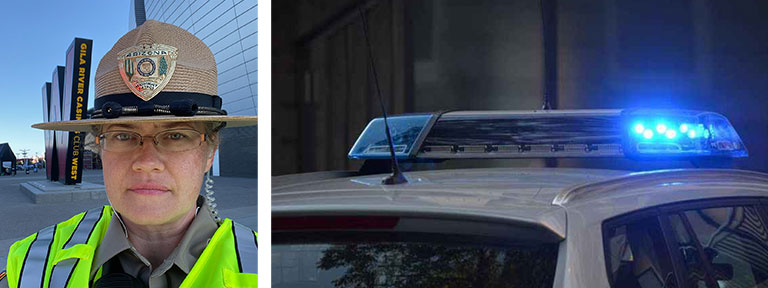On the Front Lines: Idaho and Arizona

AMBER Alerts in Idaho and Arizona End With Dramatic Rescue of Victim Hidden in Bushes
A 17-year-old girl was taking a break from her job at a Wendy’s restaurant in Jerome, Idaho, when she disappeared without any of her belongings. Earlier that day, the restaurant’s manager had ordered the employee’s ex-boyfriend to leave for making threats against the girl and her co-workers.
Eighteen-year-old Miguel Rodriguez-Perez had a protective order against him for multiple incidents of domestic violence and seriously injuring the girl. An FBI agent contacted the Idaho State Police about issuing an AMBER Alert at 3:13 p.m. on May 20, 2019.
Idaho AMBER Alert Coordinators Leila McNeill and Tanea Parmenter had to consider whether the situation met the criteria for an alert.
“With the suspect’s actions on the night of her disappearance and the possibility that he may hurt her again, we decided it was prudent to issue an AMBER Alert,” said Parmenter. “We were really concerned for her safety and felt he could potentially fatally harm her.”
The alert was issued at 4:37 p.m. for the suspect, including a description of his black Audi A4, and the victim was reported to be wearing her Wendy’s uniform.
All Idaho AMBER Alerts are sent statewide to broadcasters, highway road signs, 511 (traffic/roadway information) and lottery machines. The National Center for Missing and Exploited Children issued a Wireless Emergency Alert to notify all mobile devices in the state.
Detectives traced the suspect’s cellphone to Las Vegas, Nevada. Idaho State Police contacted Nevada authorities and a BOLO (Be On the Look Out) was issued to state law enforcement.
At the same time, the FBI received a tip about a Facebook post indicating Rodriguez Perez was on his way to Surprise, Arizona. Officers knew the suspect had ties in Arizona and Mexico and were concerned he would take the victim across the border.
Arizona AMBER Alert Coordinator Chrystal Moore with the Arizona Department of Public Safety received the request to issue an AMBER Alert in her state at 6:13 p.m. Moore issued the alert because she believed Idaho had credible evidence the suspect and victim were in Arizona.
“We were concerned for her safety, due to the history of violence,” said Moore. “We were also worried he may have already hurt her and she might not be with him by the time we would find him.”
The Arizona AMBER Alert was distributed to all law enforcement agencies, broadcasters, highway signs, the Child Abduction Response Team, U.S. Marshall’s Office, Border Patrol, Customs and Immigration–and Mexico’s Alerta AMBER coordinator in case the suspect and victim crossed the border.
A member of the public notified police about seeing the suspect’s car in Surprise, Arizona. Local officers initiated a pursuit that ended when the suspect ditched his car and fled with the victim.
Police body-camera video shows the officers approaching the car with guns drawn. They soon found the suspect hiding with the victim in the bushes near a bank.
“The person who flagged down the police was a hero,” said Moore. “This person directly assisted in the recovery of a victim of abduction.”
Moore has been involved with all 28 AMBER Alerts issued in Arizona. She said federal, state, tribal and local agencies worked flawlessly together to resolve this case. She believes Idaho deserves extra credit for looking out for the best interest of the victim.
“I was thankful she was found safe,” added Parmenter. “I was proud of the investigators, dispatchers, and everyone involved; [of] how hard they worked to locate the victim and suspect.”
Parmenter said it was helpful to have a protocol and criteria in place before the alert. Idaho issues a test alert each month to make sure everyone knows what steps to take.
This multistate alert included challenges and lessons. For example, this was the first time the FBI had asked Idaho to issue an AMBER Alert on its behalf.
“It was an eye opener to remember that more agencies need to be involved with training and practice,” said Parmenter. “This includes all federal, tribal, state and local agencies. It also means considering all law enforcement officers and investigators from the Forest Service, Probation, and Fish and Game.”
Training is also critical to the success of Arizona’s AMBER Alert program. The state has a monthly test for the federal Integrated Public Alert and Warning System (IPAWS) as well as a weekly test for the state alert system.
“Each alert is different and has its own inherent difficulties,” said Moore. “The only challenge was that the media was monitoring law enforcement channels and obtaining information shared at the scene about the cell phone being pinged by the FBI. This could have been detrimental to the case if law enforcement was not right on top of the vehicle at the time the media released this information.”
The case underscores the importance of careful strategies for interstate and cross-border collaboration, and when and how law enforcement shares information about cases through public alerts. Idaho and Arizona were well-trained and ready; despite the suspect taking the victim more than 700 miles away from her home, it was not far enough to evade these states’ finely tuned AMBER Alert programs and dedicated personnel.
